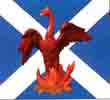Upcoming Projects:
Operation Mercury
CREFORCE
We are almost ready to begin recreating the 1941 Invasion of Crete, Operation Mercury, using the newly restored 30 ft Sand table of Simon Davison. Preparations are slowly beginning to come together, hampered by the extraneous influences of University Courses, moving houses and the general malaise which can frequently overtake the more ambitious of plans. The sand table is now inplace, and we are sure that this one will be our sucess story of 2005.
A finalised set of army lists, modified to fit Rapid fire, are being worked on, although we will probably reduce the figure scale to make the most of the large amount space we have available. The intention is to play two test games - the first one will be the landings at Maleme with the actual New Zealand dispositions, and a second using the dispositions which Freyberg felt he could not put in place because it could betray Ultra. Those games should bring out any areas of the campaign which need tweeking, and then we shall have a full invasion campaign ready to go!

The scale will be 20mm plastics, using the Rapid Fire rules, Given the scale of both the battle, and the size of the table, this should allow for, for example, the assaults on each of the 3 airfields to be carried out individually and within the scale of the rules. Troops numbers and equipment will be largely based on the excellent resource provided by American George Nafziger, whose detailed research into historical troop returns are avaliable at minimal costs.

The initial plans involve satisfying ourselves about acceptable approximations of the terrain (which can be rendered in accurate 3d thanks to the sand table), and troops, and then trying a test run of one of the landings to see if the historical result can be reasonably achieved if we follow the historical actions. After any necessary "scenario specific" rules have been again playtested, the intention is to get well stuck in. Completely free drops and landings will be available to the German command, thereby forcing the Allied commander to make his dispositions "without" the benefit of hindsight, although some allowance will be made for the knowledge gained by Ultra decoding of German signals at the time.

Part of the attraction of the campaign to the organisers is that it involves absoluetly bugger-all armour. As those who have encountered WW2 enthusiasts (or watched Channel 5) will know, they often seem more concerned with the effectiveness of the rarely seen German tiger tank, than with the much more mundane Pz III and IV workhorses. Accordingly, and in keeping with Phoenixes ethos, we decided to stuff the lot of them. Crete is a most particular battle in that there was no German armour until after the battle had been decided. The small amount (roughly two dozen armoured vehicles in total) of Commonwealth armour which was present was run down, badly repaired, and in one case, without the correct ammunition for its gun.
This makes the engagement a must more interesting prospect, and one which we hope will again show that the elite of the German army were the equal of the Commonwealth troops when they fought on equal terms, not to mention the contribution of the Greek and irregular Cretain defenders themselves!
The primary sources which we are using for this encounter are : 'The Lost Battle' - Callum MacDonald; 'Crete, The Battle and the Resistance' - Anthony Beevor; 'Battle of Crete' - George Forty; 'Touch and Go, The Battle for Crete 1941' - National Army Museum; ;Bernard Freyberg VC, Soldier of Two Nations' - Paul Freyberg; 'Official History of New Zealand in WWII, Crete' - Dan Davin; and the above mentioned George Nafziger army lists. We shall also be looking at Osprey's new book on Crete, and a rare find in the Glasgow University Library map collection has pointed us toward a 1943 British Army Survey Directorate map of Crete (GHQ MEF Crete MDR.612 1/50 000 scale) which we hope to obtain a few samples from.

